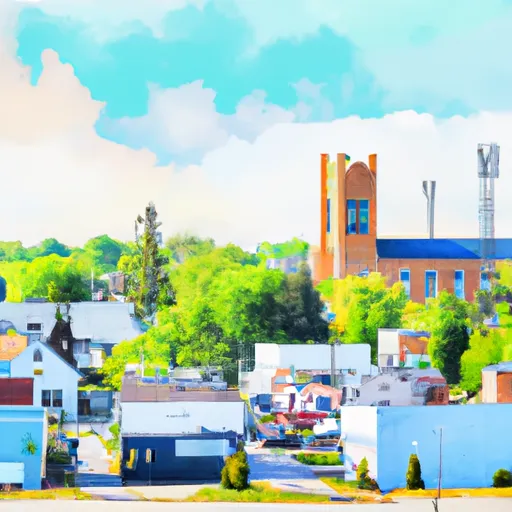-
 Snoflo Premium
Snoflo Premium
Get unlimited access to all our content
With no Ad interruptions! - Start Your Free Trial Login with existing account
Kaleva
Eden Index
Climate
7.1
•
Recreation
3.0
•
Community
•
Safeguard
3.9/10

Kaleva, Michigan is a small village located in Manistee County. Situated in the lower peninsula, it experiences a humid continental climate characterized by warm summers and cold winters. The average temperature in July, the hottest month, is around 73°F (23°C), while in January, the coldest month, temperatures can drop to 17°F (-8°C). Precipitation is evenly distributed throughout the year, with an average annual rainfall of 33 inches (84 cm) and around 70 inches (178 cm) of snowfall per year.
Kaleva is blessed with several hydrological constituents, including the Manistee River, which flows through nearby forests and provides opportunities for fishing, kayaking, and canoeing. There are also numerous inland lakes in the area, such as Bear Lake and Chief Lake, where visitors can enjoy boating, swimming, and water skiing.
Outdoor enthusiasts will find plenty of recreational opportunities in Kaleva. The surrounding forests offer excellent hiking and biking trails, including the famous North Country Trail that runs through the region. Nature lovers can explore the diverse flora and fauna, and during the winter months, there are opportunities for snowmobiling and cross-country skiing. Overall, Kaleva, Michigan is a charming destination for those seeking outdoor adventures in a picturesque natural setting.
What is the Eden Index?
The Snoflo Eden Index serves as a comprehensive rating system for regions, evaluating their desirability through a holistic assessment of climate health, outdoor recreation opportunities, and natural disaster risk, acknowledging the profound impact of these factors on livability and well-being.
Climate Health Indicator (CHI): 7.1
Kaleva receives approximately
880mm of rain per year,
with humidity levels near 82%
and air temperatures averaging around
8°C.
Kaleva has a plant hardyness factor of
6, meaning
plants and agriculture in this region thrive during a short period during spring and early summer. Most
plants will die off during the colder winter months.
By considering the ideal temperature range, reliable water supplies, clean air, and stable seasonal rain or snowpacks, the Climate Health Indicator (CHI) underscores the significance of a healthy climate as the foundation for quality living.
A healthy climate is paramount for ensuring a high quality of life and livability in a region, fostering both physical well-being and environmental harmony. This can be characterized by ideal temperatures, reliable access to water supplies, clean air, and consistent seasonal rain or snowpacks.
Weather Forecast
Streamflow Conditions
Northeastern Lake Michigan
Area Rivers
Northeastern Lake Michigan
Snowpack Depths
Northeastern Lake Michigan
Reservoir Storage Capacity
Northeastern Lake Michigan
Groundwater Levels
Recreational Opportunity Index (ROI): 3.0
The Recreational Opportunity Index (ROI) recognizes the value of outdoor recreational options, such as parks, hiking trails, camping sites, and fishing spots, while acknowledging that climate plays a pivotal role in ensuring the comfort and consistency of these experiences.
Access to outdoor recreational opportunities, encompassing activities such as parks, hiking, camping, and fishing, is crucial for overall well-being, and the climate plays a pivotal role in enabling and enhancing these experiences, ensuring that individuals can engage in nature-based activities comfortably and consistently.
Camping Areas
| Campground | Campsites | Reservations | Toilets | Showers | Elevation |
|---|---|---|---|---|---|
| Kingston Lake - State Forest | 16 | 824 ft | |||
| Fremont Lake City Park | None | 747 ft | |||
| Pines Point | 94 | 717 ft | |||
| Hurricane River - Pictured Rocks National Lakeshor | None | 625 ft | |||
| Woodland Park | 132 | 628 ft | |||
| Twelvemile - Pictured Rocks National Lakeshore | None | 620 ft | |||
| Elkhart County Fairgrounds | 222 | 803 ft | |||
| Blue Lake County Park | 25 | 670 ft | |||
| Minnie Pond | 18 | 850 ft | |||
| Diamond Lake Co Park | 60 | 953 ft |
Nearby Ski Areas
Catastrophe Safeguard Index (CSI):
The Catastrophe Safeguard Index (CSI) recognizes that natural disaster risk, encompassing floods, fires, hurricanes, and tornadoes, can drastically affect safety and the overall appeal of an area.
The level of natural disaster risk in a region significantly affects safety and the overall livability, with climate change amplifying these risks by potentially increasing the frequency and intensity of events like floods, fires, hurricanes, and tornadoes, thereby posing substantial challenges to community resilience and well-being.
Community Resilience Indicator (CRI):
The Community Resilience Indicator (CRI) recognizes that education, healthcare, and socioeconomics are crucial to the well-being of a region. The CRI acknowledges the profound impact of these elements on residents' overall quality of life. By evaluating educational resources, healthcare accessibility, and economic inclusivity, the index captures the essential aspects that contribute to a thriving community, fostering resident satisfaction, equity, and social cohesion.

